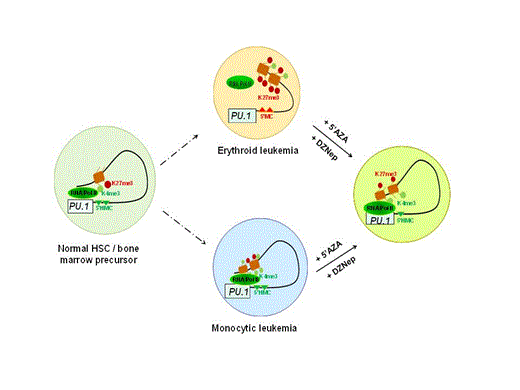Disease- or treatment-associated chromatin conformation has yet to be illustrated. Here we first demonstrate that monocytic and erythroid leukemia cell lines have distinctly different chromatin conformation at the PU.1 locus: a looped, connected, RNA-polymerase-II-bound, active conformation in the former and a disconnected, inactive conformation in the latter. These conformations undergo opposite transformations, becoming more active in the erythroid leukemia line and less active in the monocytic leukemia line, in response to both DNA and histone hypomethylating drugs.To explore the underlying mechanisms we developed a novel method to analyze DNA modifications. We demonstrate that the erythroid leukemia line has a marked drug-responsive change in both hydroxymethyl-CpG and 5-meythyl-CpG at the promoter, whereas the monocytic leukemia line has a higher level bivalent histone/chromatin with co-localized H3K4me3 and H3K27me3 at the enhancer. Consequently, the erythroid leukemia line is more sensitive to DNA hypomethylation while the monocytic leukemia line is more sensitive to histone hypomethylation. Further studies on clinical leukemia samples confirm the findings, and demonstrate that the leukemic cells from the clinical samples have different chromatin conformations with much more bivalent chromatin and denser DNA/histone modifiers and are more sensitive to hypomethylating drugs, compared to normal controls. Different chromatin conformations dictate preferential drug responses and open new diagnostic and therapeutic avenues.
Disclosures:
No relevant conflicts of interest to declare.
Topics:
chromatin,
leukemia,
molecular conformation,
histones,
dna,
leukemic cells,
rna,
monocytes,
cell lines
Author notes
*
Asterisk with author names denotes non-ASH members.
© 2013 by The American Society of Hematology
2013


